Landscape Gardening in Gardener Services: Transforming Outdoor Spaces
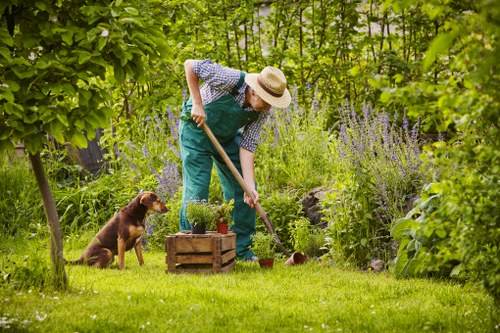
The Art and Science of Landscape Gardening
Landscape gardening is a harmonious blend of art and science, aimed at creating aesthetically pleasing and functional outdoor spaces. Whether you're looking to redesign your backyard, enhance your garden, or create a serene outdoor retreat, professional gardener services can help bring your vision to life.
At its core, landscape gardening involves careful planning and design. This process includes selecting the right plants, arranging them in a visually appealing manner, and incorporating hardscape elements like pathways, patios, and water features. The goal is to create a balanced ecosystem that not only looks beautiful but also thrives in your specific climate and soil conditions.
Professional gardeners possess the expertise to assess your property's unique characteristics, including sunlight exposure, soil quality, and existing vegetation. This comprehensive understanding allows them to design a landscape that complements your home while also meeting your personal preferences and lifestyle needs.
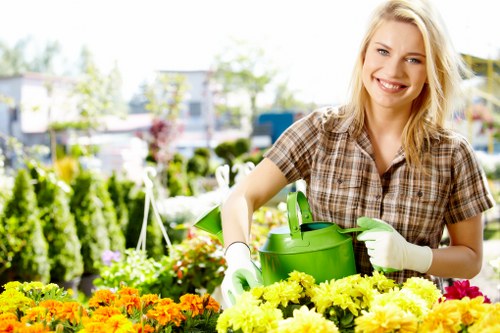
Key Elements of Effective Landscape Design
Creating an effective landscape design involves several key elements that work together to achieve a cohesive and inviting outdoor space. These elements include:
- Plant Selection: Choosing the right plants is crucial for ensuring that your garden thrives. Experienced gardeners consider factors such as climate, soil type, and maintenance requirements when selecting plants.
- Hardscaping: Incorporating structures like walkways, patios, decks, and pergolas adds functionality and visual interest to your landscape.
- Water Features: Elements like fountains, ponds, and waterfalls can enhance the ambiance of your garden, providing soothing sounds and a focal point for relaxation.
- Lighting: Proper lighting not only highlights the beauty of your garden at night but also ensures safety and usability of outdoor spaces after dark.
- Maintenance: A well-designed landscape is easy to maintain. Professional gardeners plan for sustainable practices that reduce the time and effort required to keep your garden looking its best.
By integrating these elements thoughtfully, gardeners can create outdoor environments that are both beautiful and functional, tailored to the unique needs of each client.
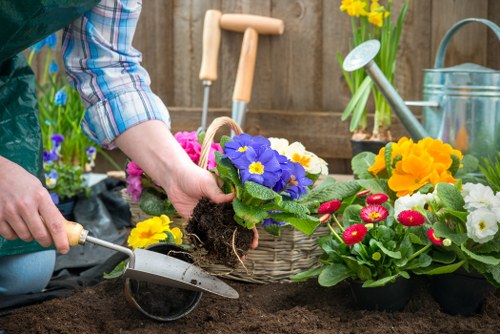
Choosing the Right Plants for Your Garden
Plant selection is a vital aspect of landscape gardening. The right plants can enhance the visual appeal of your garden, provide shade, attract wildlife, and improve air quality. When selecting plants, consider the following factors:
- Climate Suitability: Choose plants that are well-suited to your local climate. Consider factors like temperature ranges, humidity levels, and rainfall patterns to ensure your plants thrive.
- Soil Compatibility: Different plants require different soil types. Assess your soil's pH, drainage capabilities, and nutrient content to select plants that will flourish.
- Light Requirements: Determine the amount of sunlight your garden receives each day and choose plants that match those light conditions, whether they prefer full sun, partial shade, or full shade.
- Maintenance Needs: Consider the amount of time and effort you're willing to invest in maintaining your garden. Some plants require regular pruning, watering, and fertilizing, while others are more low-maintenance.
- Bloom Time and Color Palette: Plan for a variety of plants that bloom at different times throughout the year, ensuring your garden remains vibrant and colorful in every season.
Professional gardeners can guide you through the plant selection process, offering insights into the best species for your specific environment and design preferences. This expertise ensures that your garden not only looks stunning but is also sustainable and easy to care for.
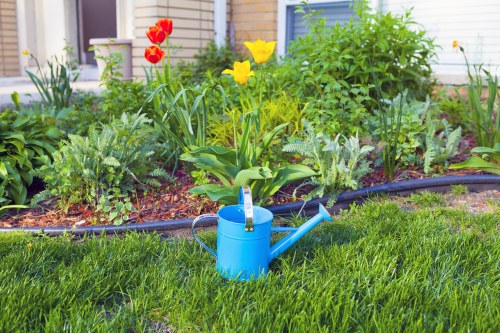
Maintenance and Care for a Thriving Garden
Maintaining a beautiful garden requires consistent care and attention. Even the most well-designed landscapes need regular maintenance to stay healthy and vibrant. Key maintenance tasks include:
- Watering: Proper irrigation is essential for plant health. Depending on the plant type and climate, watering schedules may vary. Automated irrigation systems can help ensure consistent moisture levels.
- Pruning and Trimming: Regular pruning promotes healthy growth, removes dead or diseased branches, and maintains the desired shape of plants and trees.
- Weeding: Keeping weeds under control prevents them from competing with your garden plants for nutrients and water, ensuring your flowers and shrubs can thrive.
- Mulching: Applying mulch helps retain soil moisture, regulate soil temperature, and suppress weed growth. It also adds a polished look to your garden beds.
- Fertilizing: Providing the right nutrients supports plant growth and resilience. Organic or synthetic fertilizers can be used based on the specific needs of your garden.
Professional gardener services often include comprehensive maintenance plans tailored to your garden's unique requirements. This proactive approach ensures your outdoor space remains lush, healthy, and inviting throughout the year.
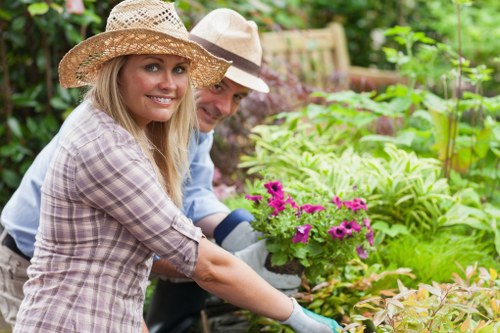
Benefits of Hiring Professional Gardener Services
Hiring professional gardener services offers numerous benefits that go beyond mere convenience. Some of the key advantages include:
- Expertise and Knowledge: Professional gardeners bring years of experience and specialized knowledge, ensuring your garden is designed and maintained to the highest standards.
- Time Savings: Managing a garden can be time-consuming. Professionals handle all aspects of gardening, allowing you to enjoy your outdoor space without the hassle of upkeep.
- Customized Solutions: Gardeners provide personalized services tailored to your specific needs, preferences, and the unique characteristics of your property.
- Quality Assurance: With access to quality tools and materials, professionals ensure that your garden not only looks great but is also built to last.
- Increased Property Value: A well-maintained and beautifully designed garden can significantly enhance the curb appeal and overall value of your property.
Investing in professional gardener services is a wise decision for anyone looking to create and maintain a stunning outdoor environment that can be enjoyed for years to come.

Innovative Techniques in Modern Landscape Gardening
Modern landscape gardening incorporates innovative techniques and sustainable practices to create environmentally friendly and resilient gardens. Some of these advancements include:
- Sustainable Landscaping: Emphasizing the use of native plants, rainwater harvesting, and eco-friendly materials reduces the environmental impact of your garden.
- Vertical Gardening: Maximizing space by growing plants vertically is especially beneficial for urban settings with limited ground area.
- Smart Irrigation Systems: Automated irrigation systems equipped with sensors optimize water usage, ensuring plants receive the right amount of moisture without waste.
- Edible Gardens: Incorporating fruit trees, vegetable beds, and herb gardens not only adds beauty but also provides fresh produce for your household.
- Hardscaping Innovations: Modern materials and creative designs for pathways, patios, and outdoor structures enhance the functionality and aesthetic appeal of your landscape.
By embracing these innovative techniques, gardeners can create gardens that are not only beautiful but also sustainable and aligned with contemporary environmental values.

Seasonal Landscape Gardening Tips
Maintaining a vibrant garden year-round requires adapting your gardening practices to each season. Here are some seasonal tips to keep your landscape thriving:
Spring
Spring is the perfect time to prepare your garden for the growing season. Key tasks include:
- Planting new flowers and shrubs.
- Pruning trees and bushes to promote healthy growth.
- Applying mulch to protect soil and retain moisture.
Summer
During the summer months, focus on:
- Regular watering, especially during dry spells.
- Weeding to prevent competition for nutrients.
- Monitoring for pests and taking appropriate action.

Autumn
Autumn is ideal for:
- Planting trees and shrubs before winter.
- Clearing fallen leaves and debris.
- Fertilizing to strengthen plants for the colder months.
Winter
In winter, concentrate on:
- Protecting sensitive plants from frost.
- Planning and designing for the next gardening season.
- Pruning dormant plants to maintain shape.
Adapting your gardening practices to each season ensures that your landscape remains healthy, vibrant, and beautiful all year long.

Eco-Friendly Practices in Landscape Gardening
Incorporating eco-friendly practices into your landscape gardening not only benefits the environment but also creates a sustainable and health-promoting outdoor space. Some key eco-friendly practices include:
- Rainwater Harvesting: Collecting and using rainwater for irrigation reduces dependence on municipal water supplies and conserves water resources.
- Composting: Utilizing organic waste to create compost enriches the soil with essential nutrients, improving plant health and reducing the need for chemical fertilizers.
- Native Plant Integration: Planting native species supports local biodiversity, attracts beneficial insects, and requires less maintenance and water.
- Sustainable Materials: Using recycled or locally sourced materials for hardscaping reduces the environmental footprint of your garden projects.
- Natural Pest Management: Employing biological controls and natural repellents minimizes the use of harmful pesticides, promoting a healthier ecosystem.
By adopting these sustainable practices, landscape gardening becomes a means to preserve and enhance the natural environment while creating beautiful and resilient outdoor spaces.

Enhancing Curb Appeal with Landscape Gardening
Your garden plays a significant role in the overall curb appeal of your home. A well-maintained and thoughtfully designed landscape can make a lasting impression on visitors and potential buyers. Here are some tips to enhance curb appeal through landscape gardening:
- Symmetrical Design: Balanced and symmetrical layouts create a sense of order and harmony, making your home appear more inviting.
- Color Coordination: Use a cohesive color palette for flowers and plants to create a visually appealing and unified look.
- Seasonal Highlights: Incorporate plants that bloom in different seasons to ensure year-round beauty and interest.
- Well-Maintained Lawn: A healthy, green lawn serves as the foundation of your garden, enhancing the overall aesthetic.
- Outdoor Lighting: Strategically placed lights highlight key features of your landscape, adding charm and safety during evening hours.
Investing in landscape gardening not only beautifies your home but also increases its market value, making it a wise long-term investment.

Integrating Functionality with Aesthetics
Balancing functionality and aesthetics is crucial in landscape gardening. Your outdoor space should not only look beautiful but also serve practical purposes that enhance your lifestyle. Here are ways to achieve this balance:
- Outdoor Living Areas: Create spaces for relaxation and entertainment, such as patios, decks, and outdoor kitchens.
- Storage Solutions: Incorporate storage areas for gardening tools and equipment to keep your space tidy and organized.
- Pathways and Walkways: Design clear and accessible paths that guide visitors through your garden while adding visual interest.
- Privacy Screens: Use plants, fences, or trellises to create private areas where you can unwind without disturbances.
- Seating Areas: Provide comfortable seating arrangements that invite you to spend more time outdoors.
By thoughtfully integrating these functional elements, your garden becomes a versatile space that meets both your aesthetic desires and practical needs.

Seasonal Plant Care Tips
Proper plant care varies with each season, ensuring that your garden remains healthy and vibrant year-round. Here are some essential tips for each season:
Spring Plant Care
In spring, focus on:
- Planting new seasonal flowers and shrubs.
- Pruning trees and bushes to encourage new growth.
- Fertilizing to provide essential nutrients for upcoming growth.
Summer Plant Care
During summer:
- Ensure consistent watering, especially during dry periods.
- Monitor plants for signs of stress or pests.
- Apply mulch to retain soil moisture and regulate temperature.

Autumn Plant Care
In autumn, prioritize:
- Planting perennials that will bloom in spring.
- Clearing fallen leaves to prevent mold and pests.
- Preparing plants for winter by pruning and protective mulching.
Winter Plant Care
During winter:
- Protect sensitive plants from frost and harsh weather.
- Plan and design your garden for the upcoming year.
- Prune dormant plants to maintain shape and health.
Adhering to these seasonal care practices ensures that your garden remains robust and ready to flourish each year.

Incorporating Sustainable Practices
Sustainability in landscape gardening is about creating eco-friendly and resource-efficient gardens. Here are some practices to consider:
- Rain Gardens: Design rain gardens to manage stormwater runoff, reduce flooding, and enhance groundwater recharge.
- Permeable Paving: Use permeable materials for walkways and patios to allow water to seep into the ground, reducing runoff and erosion.
- Solar Lighting: Implement solar-powered lights to reduce energy consumption and promote renewable energy usage.
- Composting: Create compost bins to recycle organic waste into nutrient-rich soil amendments.
- Drip Irrigation: Install drip irrigation systems to deliver water directly to plant roots, minimizing evaporation and water waste.
Embracing these sustainable practices not only benefits the environment but also creates a resilient and low-maintenance garden that stands the test of time.

Maximizing Small Garden Spaces
Even with limited space, you can create a beautiful and functional garden. Here are strategies to maximize small garden areas:
- Vertical Gardening: Utilize vertical space by growing plants on walls, trellises, and vertical planters to increase plant variety without occupying ground space.
- Compact Plant Varieties: Choose dwarf or compact plant varieties that fit well in small containers or garden beds.
- Multi-Functional Elements: Incorporate elements like garden benches with storage or trellises that serve both structural and aesthetic purposes.
- Mirrors and Reflective Surfaces: Use mirrors or reflective materials to create the illusion of a larger space and add visual depth to your garden.
- Strategic Plant Placement: Arrange plants in tiers or layers to maximize space and create a lush, full appearance.
With thoughtful design and creative solutions, even the smallest garden spaces can become charming and inviting retreats.

Enhancing Privacy with Landscaping
Creating privacy in your outdoor space allows you to enjoy your garden without outside interruptions. Effective ways to enhance privacy include:
- Hedges and Shrubs: Plant dense hedges or tall shrubs to act as natural barriers between your garden and neighboring properties.
- Trellises and Pergolas: Install trellises or pergolas covered with climbing plants to create secluded areas within your garden.
- Fencing: Use fences designed with privacy in mind, such as solid wooden fences or vinyl panels, to block unwanted views.
- Layered Planting: Combine different plant heights and types to create a multi-layered screen that provides both beauty and seclusion.
- Strategic Layout: Position seating areas and focal points away from street views to enhance the sense of privacy.
By thoughtfully incorporating these elements, you can create a serene and private oasis within your landscape garden.

Integrating Water Features for Serenity
Water features add a soothing and dynamic element to your garden. They can serve as focal points, attract wildlife, and create a tranquil atmosphere. Popular water features include:
- Fountains: Elegant fountains provide the calming sound of flowing water and serve as central garden features.
- Ponds: Ponds can support aquatic plants and wildlife, adding biodiversity to your garden ecosystem.
- Waterfalls: Waterfalls create a dramatic and naturalistic water flow, enhancing the visual appeal of your landscape.
- Birdbaths and Wildlife Ponds: These attract birds and other wildlife, contributing to the ecological balance of your garden.
- Streams and Creeks: Artificial streams can mimic natural waterways, adding movement and life to your garden design.
Incorporating water features requires careful planning to ensure proper installation and maintenance. Professional gardener services can help you select and design water elements that complement your landscape and meet your preferences.

Lighting Solutions for Your Garden
Outdoor lighting enhances the beauty and functionality of your garden after dark. Effective lighting design can highlight key features, ensure safety, and create ambiance. Key lighting solutions include:
- Pathway Lighting: Illuminate walkways and paths to ensure safe navigation and add a welcoming glow to your garden.
- Accent Lighting: Highlight specific garden features such as trees, sculptures, or water elements with focused lighting.
- Ambient Lighting: Use soft, diffused lighting to create a warm and inviting atmosphere for outdoor gatherings.
- Solar-Powered Lights: Eco-friendly solar lights provide illumination without relying on external power sources, reducing energy consumption.
- String Lights and Lanterns: Decorative lights add charm and a festive touch to patios, decks, and garden areas.
Professional installation of garden lighting ensures that your outdoor space is both beautiful and safe, allowing you to enjoy your garden long after the sun sets.

Creating Sustainable Gardens
Sustainability in gardening is about creating a landscape that is environmentally responsible and resource-efficient. Here are some strategies to create a sustainable garden:
- Use Native Plants: Native species are adapted to your local climate and soil conditions, requiring less water and maintenance.
- Reduce Lawn Areas: Lawns can be water-intensive. Incorporate ground covers, perennials, or artificial turf to reduce water usage.
- Compost Organic Waste: Composting kitchen scraps and garden waste enriches the soil and reduces landfill contributions.
- Install Efficient Irrigation: Drip irrigation and smart watering systems minimize water waste and ensure plants receive adequate moisture.
- Promote Biodiversity: Encourage a diverse range of plants and wildlife to create a resilient and balanced ecosystem.
Implementing these sustainable practices not only benefits the environment but also results in a healthier and more enduring garden.

Personalizing Your Garden Space
Your garden should reflect your personality and lifestyle. Personalizing your outdoor space makes it a unique extension of your home. Consider the following approaches:
- Themed Gardens: Create a garden with a specific theme, such as a Zen garden, butterfly garden, or cottage garden, to showcase your interests.
- Custom Plant Arrangements: Arrange plants in patterns or groupings that resonate with your aesthetic preferences.
- Decorative Elements: Incorporate sculptures, artwork, or decorative pots to add character and flair to your garden.
- Personal Seating Areas: Designate spaces for relaxation and reflection that cater to your personal comfort and style.
- Color Schemes: Choose a color palette that complements your home's exterior and creates a harmonious visual flow.
Personalizing your garden ensures that it becomes a space you love and enjoy, seamlessly blending beauty with your unique identity.

Conclusion: Invest in Professional Garden Services
Landscape gardening is a powerful way to enhance the beauty, functionality, and value of your outdoor spaces. From design and plant selection to maintenance and sustainability, professional gardener services provide the expertise and dedication needed to create and sustain a stunning garden.
Whether you're starting from scratch or looking to revamp an existing garden, investing in professional services ensures that your vision is realized with precision and care. Don't hesitate to contact us today to transform your garden into the oasis you've always dreamed of.
Ready to elevate your outdoor space? Book your service now and take the first step towards a beautiful and thriving garden.